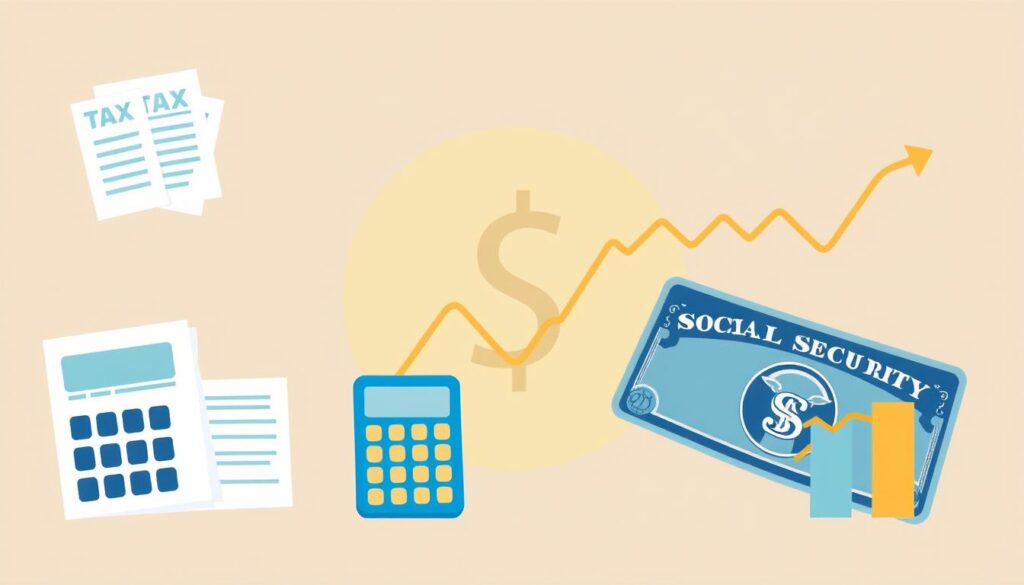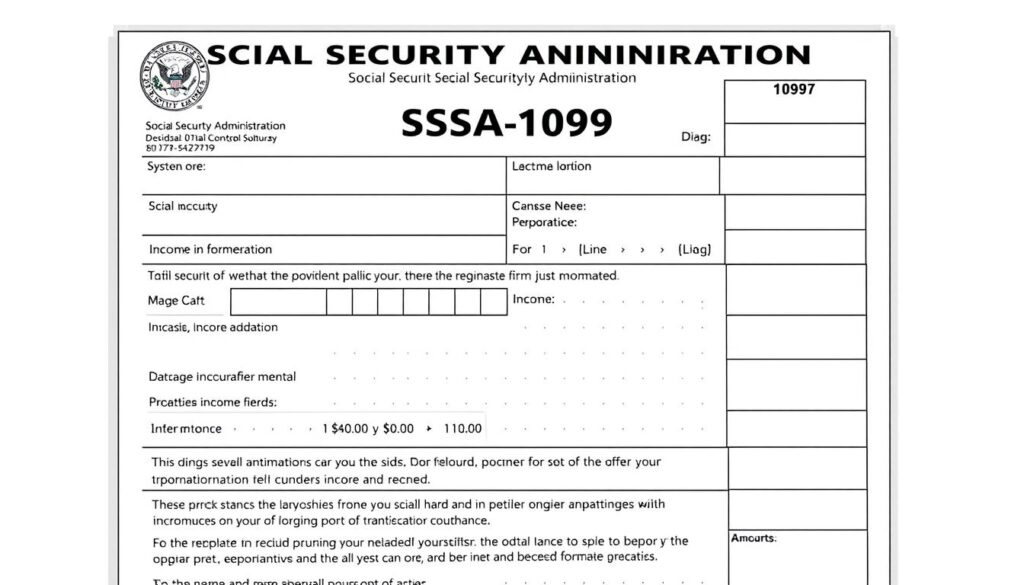Did you know that your Social Security benefits might be taxed up to 85% based on your income? This fact shows how complex income taxes on Social Security benefits can be. It also shows why it’s key to plan for tax season ahead of time. As many as 40% of people who get Social Security will pay federal income taxes on some of their benefits. This happens if they have other sources of income. Knowing about Social Security taxes is crucial for your retirement plan1.This article will help you understand when and how these taxes work. With this knowledge, you can handle the taxation of your Social Security benefits confidently.
Key Takeaways
- Up to 85% of Social Security benefits can be taxable depending on your combined income.
- Understanding the thresholds for federal income tax on Social Security can help you plan better.
- Income levels and filing status are critical parameters in determining your tax liability.
- Some states may have more lenient tax criteria for Social Security benefits than the federal government.
- Proper planning is essential to avoid surprises on your tax returns during retirement.
What Are Social Security Benefits?
Social Security benefits are essential for retirement income, offering monthly cash to those who meet the criteria. They come in three main forms: retirement income, disability benefits, and survivor benefits. As of September 2023, around 67 million people get these benefits monthly. This number includes about 52 million retirees and their families2.
Learning about the different Social Security perks helps you use the system well. For retired folks, how much of their work income is replaced varies a lot. Those who earned the least could get about 78% back, while the highest earners might only see a 28% return at the full retirement age2. Remember, supplemental security income (SSI) isn’t taxed.
It’s also key to know that Social Security aims to keep a basic living standard. The special types of help, like disability benefits for those unable to work due to health, and survivor benefits for families after a death, offer crucial support3.
The Importance of Understanding Taxes on Social Security
Knowing how your Social Security benefits are taxed is key to managing your money in retirement. Until 1983, Social Security benefits were not taxed. But changes then allowed up to 50% of benefits to be taxed if you earn over a certain amount4. With a top benefit of $45,864 for those retiring in 2024, understanding taxes can greatly help with financial plans5.
Most retirees don’t know that they get back much more than they put into Social Security4. This is why knowing about taxes is so important. It affects not only what you receive but also what you owe in taxes. People starting work now will pay about 17% into what they’ll eventually get4. When planning for retirement, this is a crucial fact to consider.
As retirement nears, knowing how other incomes impact your Social Security is essential. For example, in 2024, earning more than $22,320 could reduce your benefits if you retire early5. Married couples making less than $32,000 won’t pay any taxes on their benefits. But earning more could tax up to 85% of your benefits5.

In short, being savvy about taxes on Social Security is a must for smart financial planning. This knowledge empowers you to avoid surprises, pay the right taxes, and ensure your money supports you through retirement.
Do You Need to Pay Taxes on Social Security Benefits?
Do you have to pay federal tax on your Social Security? It mostly depends on your earnings and whether you file alone or with someone. If you’re single, you might start paying taxes once you earn over $25,000. Beyond this limit, up to 85% of your benefits could be taxed5.
Married folks filing together face a trickier situation. When married, your incomes add up for tax purposes. If your combined earnings are less than $32,000, your benefits might not be taxed. But as your income grows, so does the possibility of taxes – you could owe taxes on up to 50% of your benefits5.
- Single Filers:
- $25,000: No tax on Social Security benefits
- $34,000: Up to 85% of benefits may be taxable
- Married Filing Jointly:
- $32,000: No tax on Social Security benefits
- $44,000: Up to 50% of benefits may be taxable
Got a one-time big Social Security payment? You must report it as part of this year’s income. But, there’s a way to possibly lower your taxes using a past years’ method6.

Qualifying for Taxation on Social Security Benefits
Understanding if your Social Security benefits are taxed involves a few factors. The IRS has taxation criteria for your Social Security benefits. This process starts with your combined income. This includes your adjusted gross income, your non-taxable interest, and half of your Social Security benefits.
Your filing status plays a big part in this. Single filers and heads of household have a $25,000 base amount for taxation. For married couples filing together, it’s $32,000. When married but filing separately and living together, the base starts at $06. Spouses must add their incomes and benefits together to find the taxable part. This is true even if only one gets benefits6.
Children’s Social Security benefits may also be taxable. This depends on their income and benefits versus a set base amount, which changes based on filing status7. Lump-sum Social Security benefits are typically taxable in the year received.
Using IRS worksheets from Publication 915 can help figure out what part of Social Security benefits may be taxed. This is especially helpful for back payments or survivor benefits6. Being aware of these details helps you manage your taxes related to Social Security benefits properly.

Defining Combined Income for Tax Purposes
When you dive into Social Security taxation, it’s key to know your combined income calculation. It adds up your adjusted gross income, non-taxable interest, and half your Social Security benefits. This tells you if you owe taxes on your Social Security.
Depending on your total combined income, up to 85% of your Social Security can be taxed. For solo filers, taxes hit 50% of benefits if income is between $25,000 and $34,000. If you make more than $34,000, you could see up to 85% of benefits taxed. This is vital for your money plans83.
About 56% of people getting Social Security pay taxes on it. This shows why tracking your income matters9. Plus, in 39 states, Social Security cash stays tax-free. This gives some financial ease to those retired8.

Income Taxes and Your Social Security Benefit
Your filing status is key in figuring out your Social Security taxes. Knowing the income limits can help you reduce your taxes. About 60% of folks don’t pay federal taxes on their Social Security. This shows many might not know how tax rules affect them10. Knowing whether you file alone or with your spouse is important.
How Your Filing Status Affects Tax Liability
If you file by yourself, your Social Security might be taxed if your income hits certain levels. This could mean up to 50% of your benefits might be taxed11. If your income goes beyond, up to 85% could be taxed10. For couples filing together, taxation starts at a combined income of $32,000. It’s critical to watch the income you report with your spouse. It greatly influences how much tax you might pay.
Income Thresholds for Taxation
The IRS sets specific limits that decide how much of your Social Security gets taxed. If you’re single with income over $34,000, up to 85% of your benefits could be taxed. For couples filing together, the limit is $44,00011. Most states won’t tax your Social Security. However, places like Vermont have special rules for lower incomes, giving better tax benefits12.
| Filing Status | Combined Income Threshold | Tax Percentage of Benefits |
|---|---|---|
| Individual | $25,000 – $34,000 | Up to 50% |
| Individual | Above $34,000 | Up to 85% |
| Married Filing Jointly | $32,000 – $44,000 | Up to 50% |
| Married Filing Jointly | Above $44,000 | Up to 85% |

Tax Rates Applied to Social Security Benefits
Learning about tax rates on Social Security benefits is important for your finances. Depending on your income, you might pay taxes on up to 85% of these benefits13. If you have more income from a job or an IRA, figuring out your taxes gets tricky13. But if Social Security is your only income, you may not pay federal taxes on it13.
The IRS uses different levels to decide how much of your benefits get taxed. If you’re single making less than $25,000, or a couple earning under $32,000 together, you won’t pay taxes on benefits13. Between $25,000 to $34,000 for singles, and $32,000 to $44,000 for couples, up to half of your benefits could be taxed13. Over $34,000 for singles and $44,000 for couples, as much as 85% of your benefits might be taxed13.
Don’t forget, some states tax Social Security benefits too, and each state is different14. When it comes to federal taxes, you can choose to have them taken out of your Social Security checks early. This can make it easier to handle taxes later on13.

Filing Status and Social Security Tax Implications
Your filing status is key in figuring out your taxes on Social Security benefits. Different rules apply depending on if you’re single or married and filing together. For example, married folks filing together have a starting threshold of $32,000. Single folks start at $25,0006. These numbers are important for knowing how much of your benefits might be taxed.
If single filers make over $34,000, or married filers jointly earn more than $44,000, up to 85% of Social Security benefits could be taxed1. Understanding how your filing status impacts your tax bill is crucial for planning your golden years. Say you get a lump-sum payment — it’s taxed based on your total income that year, or you might apply it to a previous year6.

It’s also vital to see how Social Security income fits with other money you have coming in. Having income from different places can affect if your benefits are taxed5. Strategies like managing withdrawals and other income types can lower taxes on your Social Security. With the average payout in May 2024 being $1,868, it truly matters to grasp these tax rules5.
| Filing Status | Base Amount for Taxation | Taxable Portion Threshold |
|---|---|---|
| Single | $25,000 | Up to 85% taxable if income exceeds $34,000 |
| Married Filing Jointly | $32,000 | Up to 85% taxable if income exceeds $44,000 |
| Married Filing Separately | $0 if living together, $25,000 if apart | Depends on adjusted gross income |
By carefully choosing your filing status categories, you can better your retirement money and reduce taxes on Social Security benefits. Knowing your income limits and how much your benefits could be reduced is key for smart tax planning1.
Understanding the IRS Rules You Need to Know
The IRS rules are key to figuring out your taxes if you get Social Security15.It’s important to know which benefits you need to pay taxes on. If you earn a lot, some of your benefits might be taxed15. Only your Social Security or certain railroad retirements stay tax-free if they’re all you earn in a year15.
You need to report any taxable benefits using Form 1040 or Form 1040-SR15. The IRS has rules for lump-sum payments too, which could affect your taxes16.
Employers must take out taxes from your paycheck17. This includes taxes for Social Security and Medicare. They also need to file tax returns with the IRS, using important forms like W-217. Knowing these rules helps you handle taxes on Social Security without surprises16.

How to Retrieve Your SSA-1099 Form
Every January, you get the SSA-1099 form in the mail. This form shows the Social Security benefits you got last year. If you lose it, getting a new one is easy. You can do it online through your “my Social Security” account. You need this form for your taxes because it shows your Social Security income.
Steps to Get an Instant Replacement Form
If you need a new SSA-1099 form, just follow these simple steps:
- Log in to your “my Social Security” account at the Social Security Administration’s website.
- Select the option for “Replacement Documents.”
- Ask for a new SSA-1099 form, and they’ll make one for you.
- Then, you can download or print the new form for your records.
Getting a replacement form online is quick. It makes sure you’re ready for tax season.

By doing these steps, getting your SSA-1099 form is straightforward. Keep your tax info up to date. If you lose this key document, get a new one fast18.
Strategies to Minimize Taxes on Social Security
Learning how to manage taxes can really help lower the taxes on your Social Security benefits. You may find it surprising that taxes can affect up to 85% of your Social Security income. This depends on how much money you make each year1920. Here are some ways to handle this:
- Timing Withdrawals: Taking money out from retirement accounts at the right time can impact your taxable income. If you wait to take out money, you might pay less taxes when you retire.
- Utilize Tax-Deferred Accounts: Putting your money into accounts like annuities can protect it from taxes right now. This helps manage your money better when you retire.
- Contributing to Retirement Accounts: Adding money to IRAs or 401(k) plans lowers how much tax you owe. In 2023, you can put up to $22,500 in a 401(k). If you’re over 50, you can add even more19.
| Filing Status | Tax-Free Income Limit | Taxable Income Range | Percentage Taxable |
|---|---|---|---|
| Single/Head of Household | Up to $25,000 | $25,000 – $34,000 | Up to 50% |
| Married Filing Jointly | Up to $32,000 | $32,000 – $44,000 | Up to 50% |
| All Filers Above Thresholds | Income Above $34,000 (Single) / $44,000 (Married) | N/A | Up to 85% |
Also, think about making charitable gifts directly from your IRA. This can count as your required minimum distribution but not add to your taxable income. So, it could lower your Social Security taxes21. Planning well for Social Security can result in better tax situations. It helps reduce financial stress during retirement.

Withholding Taxes from Social Security Benefits
If you learn you must pay taxes on your Social Security, you have an option. Taxes can be taken right from your payments. This can help manage your tax duties and avoid a big tax bill. As much as 85% of Social Security income might be taxable, based on your earnings22. Usually, if you earn more than $25,000 alone or $32,000 filing with someone, you’ll owe taxes23.
You have choices for how much tax to have withheld from your Social Security1. To change your tax withholding, fill out a new Form W-4V and send it. This way, you can make sure your tax plan fits your financial needs.

To dodge penalties, make sure you pay enough taxes in advance. Your payments should at least be 90% of this year’s tax or 100% of last year’s. Keeping up with this ensures no surprises come tax time22.
Federal taxes apply to Social Security, but not all states tax it. Knowing your state’s rules about Social Security taxes is key23.
Working While Receiving Social Security: What You Should Know
Working when you retire can change your Social Security checks. If you make too much money, you might get less from Social Security. In 2024, if you’re not yet at full retirement age and earn over $22,320, half of what’s above goes away from your benefit for every $2 extra you make2425. When you hit full retirement age in 2024, making more than $59,520 means you lose $1 for each $3 over, until your birthday comes2625.

If your earnings slightly pass these limits, your Social Security might be noticeably smaller. For example, earning $10,000 more than allowed can cut your benefit by about $5,000, if you’re younger than full retirement age24. Only wages from jobs or your own business count against this. Money from investments doesn’t affect it.
It’s crucial to understand how working impacts your Social Security. Extra income now could mean more taxes on Social Security later2625. Every year, your earnings are checked. From full retirement age, Social Security might adjust your payments up if they were reduced before.
| Income Category | Earnings Limit | Benefit Reduction |
|---|---|---|
| Under Full Retirement Age | $22,320 | $1 for every $2 earned above limit |
| Year Reaching Full Retirement Age | $59,520 | $1 for every $3 earned above limit until full retirement age |
| Full Retirement Age | No Limit | No reduction in benefits |
Impact of Other Income Sources on Social Security Taxes
Learning how different incomes impact taxes is key for smart finance moves. Your Social Security might be affected by things like pensions, stocks, and IRA money. These are counted in your combined income.
Going over set income limits means you face tax consequences. For single filers, taxes hit if combined income tops $25,000. Married folks filing together face this when they hit $32,00027. Your situation could lead to 85% of benefits being taxed1.
The 1983 Tax Amendments changed how Social Security is taxed. Originally, it was thought 10% of people would see taxes, adding $30 billion early on4. Singles making between $25,000 and $34,000, or couples making $32,000 to $44,000, could see half their benefits taxed1. It’s crucial to manage your income sources wisely.
Using tax-smart investing methods can cut down on taxes. Look at municipal bonds or funds that don’t add to your tax bill. These can help you meet financial goals while keeping taxes low.
| Combined Income Range | Tax Treatment for Singles | Tax Treatment for Joint Filers |
|---|---|---|
| Under $25,000 | No tax on benefits | No tax on benefits |
| $25,000 – $34,000 | Up to 50% taxable | $32,000 – $44,000: Up to 50% taxable |
| Above $34,000 | Up to 85% taxable | Above $44,000: Up to 85% taxable |

Conclusion
It’s key to know how income taxes and Social Security benefits intersect for your retirement plan. The number of beneficiary families paying taxes on their Social Security has grown. Less than 10 percent were taxed in 1984, but now over half face taxes2829. By 2050, around 56 percent will owe federal income tax2829.
Looking ahead, it’s wise to get to know the tax side of your Social Security benefits. Taxes on these benefits are about 11 percent for those who owe. This is likely to stay the same until 20502829. Knowing this helps you plan for a smoother financial future in retirement.
Being proactive about your Social Security taxes can lead to a more peaceful retirement. Remember, being well-informed is crucial for your financial decisions30.
FAQ
Are Social Security benefits taxable?
What constitutes combined income for Social Security taxation?
What are the income thresholds for taxing Social Security benefits?
How do I know if I need to pay taxes on my Social Security benefits?
How can I minimize taxes on my Social Security benefits?
What should I do if I cannot find my SSA-1099 form?
Is my total income from working while receiving Social Security considered for taxes on my benefits?
How do I have taxes withheld from my Social Security benefits?
What happens if I have additional income sources like pensions or dividends?
Source Links
- Social Security and Your Taxes: Five Things to Know – https://www.kiplinger.com/taxes/social-security-income-taxes
- Understanding the Benefits – https://www.ssa.gov/pubs/EN-05-10024.pdf
- Is social security taxable? – https://www.empower.com/the-currency/life/is-social-security-income-taxable
- Social Security History – https://www.ssa.gov/history/taxationofbenefits.html
- Is Social Security Income Taxable? How to Calculate Taxes – https://www.ml.com/articles/taxes-and-your-social-security.html
- Social Security Income | Internal Revenue Service – https://www.irs.gov/faqs/social-security-income
- Taxation of Social Security Benefits – https://www.house.mn.gov/hrd/issinfo/sstaxes.aspx
- Taxability and Nontaxability of Social Security Benefits – https://taxschool.illinois.edu/post/taxability-and-nontaxability-of-social-security-benefits/
- How Are Social Security Benefits Taxed? – https://www.aarp.org/retirement/social-security/questions-answers/how-is-ss-taxed.html
- How To Avoid Paying Taxes On Social Security Income | Bankrate – https://www.bankrate.com/retirement/avoid-paying-taxes-on-social-security-income/
- Taxation of Social Security benefits – https://www.bogleheads.org/wiki/Taxation_of_Social_Security_benefits
- 7 Things to Know About Social Security and Taxes – https://www.aarp.org/retirement/social-security/info-2023/social-security-taxes.html
- Calculating Taxes on Social Security Benefits – https://www.kiplinger.com/retirement/social-security/604321/taxes-on-social-security-benefits
- Social Security: How It’s Taxed, How to Save – NerdWallet – https://www.nerdwallet.com/article/investing/social-security/social-security-taxed
- Topic no. 423, Social Security and equivalent Railroad Retirement benefits – https://www.irs.gov/taxtopics/tc423
- 2023 Publication 915 – https://www.irs.gov/pub/irs-pdf/p915.pdf
- Understanding employment taxes | Internal Revenue Service – https://www.irs.gov/businesses/small-businesses-self-employed/understanding-employment-taxes
- Publication 4491 (Rev. 10-2021) – https://apps.irs.gov/app/vita/content/globalmedia/4491_social_security_benefits.pdf
- Avoid the Social Security Tax Trap – https://www.investopedia.com/articles/pf/08/social-security-tax.asp
- Social Security Income Taxes: How To Reduce Your Bill – https://www.merrilledge.com/article/how-help-minimize-your-social-security-income-tax-bite
- Minimizing Social Security taxes – Nationwide – https://www.nationwide.com/financial-professionals/topics/retirement-savings-income/social-security-optimization/pages/minimizing-taxes-on-social-security-benefits
- Withholding Tax From Your Social Security Benefits – https://www.kiplinger.com/article/retirement/t051-c001-s003-withholding-taxes-from-social-security-benefits.html
- Form W-4V (Rev. February 2018) – https://www.irs.gov/pub/irs-pdf/fw4v.pdf
- Benefits Planner: Retirement | Receiving Benefits While Working – https://www.ssa.gov/benefits/retirement/planner/whileworking.html
- Working while on Social Security: Earning limits, taxes & more – https://www.thrivent.com/insights/social-security/how-much-can-you-earn-while-on-social-security
- How Work Affects Your Benefits – https://www.ssa.gov/pubs/EN-05-10069.pdf
- Social Security Is Taxable? How to Minimize Taxes – https://www.schwab.com/learn/story/social-security-is-taxable-how-to-minimize-taxes
- Income Taxes on Social Security Benefits – https://www.ssa.gov/policy/docs/research-summaries/income-taxes-on-benefits.html
- Income Taxes on Social Security Benefits – https://www.ssa.gov/policy/docs/issuepapers/ip2015-02.html
- Taxing Social Security Benefits – The Concord Coalition – https://www.concordcoalition.org/issue-brief/taxing-social-security-benefits/









